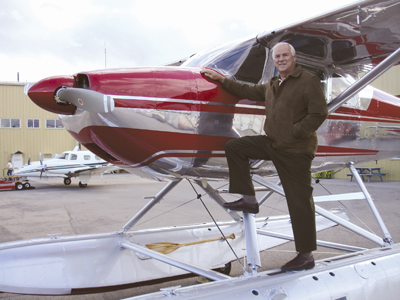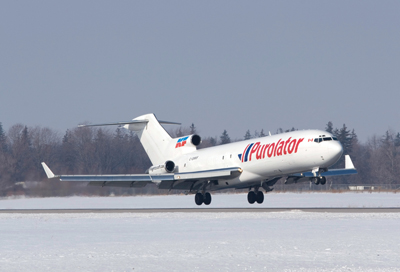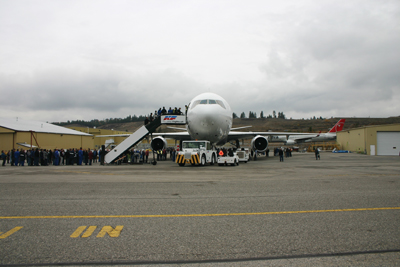
Features
Operations
One on One With Barry Lapointe
Kelowna Flightcraft Limited was established on March 20, 1970 and Kelowna Flightcraft Air Charter in June 1974. How have both companies grown since then?
March 26, 2009 By Darren Locke
Kelowna Flightcraft Limited was established on March 20, 1970 and Kelowna Flightcraft Air Charter in June 1974. How have both companies grown since then?
 |
|
| Barry Lapointe is president of Kelowna Flightcraft.
|
The air charter business has grown terrifically. We’ve tried various avenues in terms of flying airplanes, the charter side, from forestry patrols in the early days of 1974 to inter-city air back in 1984, the transcontinental cargo routes that we started with Purolator in 1976. And then we got into Greyhound Air and we continued to expand the Purolator system to what it is today. So we’ve gone through quite a growth in the air charter side of our business. In regard to (Kelowna Flightcraft) Limited – if you fly an airplane, you have to maintain it. So Limited is really the maintenance arm of Kelowna Flightcraft, and is the actual parent company, because we started in 1970 repairing, selling, marketing small airplanes, that kind of stuff. And that developed into quite an MRO, a maintenance organization. When you fly at night all the time, the time to maintain your airplanes is usually on the weekends, so we needed quite a concentrated workforce to do that. And of course you’ve got to keep the rest of the week happy, and that’s how we got into the maintenance repair organization. But our growth has been more into the actual flying of airplanes than it has been into the maintenance end.
I think if you were really to use the success word of the Kelowna Flightcraft group of companies, the word is “diversification.” If you look at the spectrum of what we do, we train military pilots in Portage; we maintain the type certificate for Convair airplanes all over the world – we’re an aircraft manufacturer I guess is what I’m saying – we have charter in Purolator and Canada Post; and we have our MRO business, which is continuing to grow with major airlines all over the world…. Each arm is now very successful and contributes to the parent company.
That’s the nice thing about being as diversified as Kelowna Flightcraft is. Our charter business may drop, but the MRO business stays up. The military pilot training is fairly sustainable, people maintain airplanes all over the world. We’ve built fire tankers for the Saskatchewan government, for Convair. You always have to look at ever-evolving change in your company and really keep your core business. I’ve always hated that expression “you’ve got to think out of the box.” No, you stay within your box, but you broaden the parameters of your box. You don’t step out of your box – don’t start building apartments, don’t start owning car manufacturing. Stay within your box of aviation, but broaden it within, so it’s all intermingled with your core business.
We serve Purolator and Canada Post, we pretty well cover most major cities – Victoria, Vancouver, Calgary, Edmonton, Regina Saskatoon, Winnipeg, Thunder Bay, Toronto area, Ottawa, Montreal, Moncton, Halifax, St. John’s. Draw that line 100 miles wide and 3,000 miles long across Canada and we’re pretty well in every major city. We carry around 600,000 pounds of freight every night, and now about 300,000 pounds extra for Canada Post, so we’re pushing around a million pounds of freight a night across Canada.
Is Hamilton International Airport an effective hub for Kelowna Flightcraft air charter in central Canada?
It’s funny you should say that Hamilton is Central Canada – I always think of Hamilton as Eastern Canada, I don’t know why. We determined almost 11, 12 years ago that what was happening at Toronto International, with the noise and the curfews, and with the draconian approach that Lou Turpen was going to be taking, that there was just no way cargo operators could operate there consistently in the realm of budgetary realities. We can’t be a FedEx and build a $50-million complex, so we looked around and Hamilton was kind of like the Sleepy Hollow of airports. We were one of the first to go in there and build a facility. I don’t think there had been anything built in Hamilton for 40 years. We looked at it, the Hamilton people were very happy to see us, we developed it, and we find that Hamilton is as close to Toronto as you can possibly be and still service that central Toronto area. It works great as a hub, we were able to negotiate some great concessions as far as curfews go, and we have grandfather rights going into Hamilton at night, so we’re not going to be constrained by that. Hamilton is beginning to emerge as a great second-tier airport, as Abbotsford is to Vancouver. We’re very pleased with Hamilton, and it’s worked out very well and certainly the airport authority there has been pretty easy to work with. We’ve been there, we’ve brought a lot of business for them. We’ve helped Hamilton develop into what it is today. They appreciate us.
We’re bringing large airplanes in, the largest airplanes that I think have ever been in there. I think it’s worked out very well for us, and we don’t have the heavy traffic as much as Toronto. I mean, Toronto’s a great airport, but I just think the cost, it’s one of the most expensive airports in the world if I’m not mistaken, but they’re changing now. Toronto International, in the days of the Lou Turpens, made it very clear that they didn’t want cargo – they were not a cargo airport. “Go away.” When he (Louis A. Turpen, president/CEO of Greater Toronto Airports Authority, 1995-2004; previously San Francisco’s director of airports) was in San Francisco he pushed cargo all over to Oakland. It was just his mentality, that freight is midnight stuff and it doesn’t generate passenger revenue and restaurants and parking. It doesn’t do that, so go someplace else. That’s fine. I’m sure Memphis thought of that when FedEx first started in there back in the early ‘60s, and look at it now. Memphis is very dependent on FedEx. Cargo is a consistently growing, clean industry. You don’t have to worry about parking lots and security and people and stuff. It’s pretty well a no-brainer for revenue as far as landing fees and space goes.
 |
|
| Boeing 727 C-GWKF of Kelowna Flightcraft Air Charter Ltd. operated for Purlator Courier. Kelowna’s new colours similar to those painted on Kelowna’s newly acquired DC-10s are seen applied to the first of the 727 fleet. (Photo by Andrew Cline)
|
For many years the Boeing 727-200F has served as the backbone of you fleet. How has it performent for you and what types of aircraft do you see as its potential replacement?
We started off with the 727-100 because that filled our niche. Freight’s a little different than passenger – you’ve got to look at your load capacity and what it will carry, because you’ve got to fly a freighter 100-per-cent full to be profitable. Below that, it’s not like a passenger plane. So you always match capability and load to the airplane you’re going to use. We started off many years ago with Convair 580s flying across the country, because that’s all we were carrying, 12,000, 14,000, 15,000 pounds of freight. We grew into the 100, and then into the 200. Now the 200 has been pretty well recognized around the world – FedEx, UPS, every major carrier has operated 727s. They made over 1,000 of them, so they’re a very good, reliable three-engine airplane. I just can’t say enough about the 727 – it has certainly worked great for us. It lost its lustre in the passenger business with the new-generation 737s, but even today if you take a 737-300 or a 737-400 freighter, it doesn’t even touch the 727-200.
We’ve looked at the 727 replacement airplanes, and the trendsetter has always been the big courier companies. FedEx now has made a commitment for 95 757-200 freighters to replace their 727-200s. But when you’ve got a system like we have in Canada, that corridor, where you’ve got long routes, four time changes, you can’t afford a $20- to $25-million airplane flying 100 hours a month. If I was flying this airplane 300 hours a month, then I’d have to take a look at something different, which would probably be a 757 or 767 or something like that. (But) we can’t afford to go to Boeing and make a 757-300 cargo, it’s $60 million, you can’t do it. The capital cost just burns you out. So you have to have a low-capital-cost airplane, a reliable airplane, with the understanding that it’s only going to fly 100 hours a month. I really question Cargojet when they went to the 767s, because unless you have something up your sleeve, flying it 200 or 300 hours a month, it just doesn’t make economic sense. It’s not sustainable, and I think they’ll find that out. We looked at that airplane, and if somebody says “what is the replacement for the 727-200,” I’m saying “a newer 727-200.” They made them up to 1984. I’ve got some that are 1968, I’m replacing the 1968, 1970 models with 1980, 1984 models. I’ve talked to Boeing, and they finally gave up saying “we’re going to ground the airplane at 50,000, 60,000 hours.” We’ve got airplanes that have got 50,000, 60,000 hours on them, and we’re saying, “why?”
If I had to start maintaining a 727 to fly 300 hours a month, I would be looking at probably a 757 because I can justify the cost, because I’m getting the utilization out of it. But on the particular geographic routes that our airplanes fly it just doesn’t warrant it, and the most important thing to my customers is to get it there on time, and get it there reliably. We’ve got reliability, and we’ve got a good time. You can’t fly any faster than a 727, they’re a Mach 0.82 airplane. So to carry another container at three times the cost just doesn’t make sense.
And if you think of that philosophy, that’s one of the reasons why we went into the DC-10s, because when you looked at the load that Canada Post wanted to carry, it was obvious you had to get the biggest freighter at the cheapest price. We looked at DC-10s, we looked at L-1011s, and we looked at 747s, and that’s it. For the wide-bodies, there’s nothing else out there. The L-1011 is a great airplane but it’s just not being supported by Lockheed anymore, so that was pretty well off the table. The 747’s a great airplane, but again what it does with four engines a DC-10 does with three. Again you look at capital costs, you look at operational costs, you look at the low utilization, but you need the big bulk, you need the 160,000 pounds carrying capability. The DC-10 was a natural, but people say “oh, it’s an old airplane.” Yes it is, but you know what, we’re not afraid of old airlplanes. I like airplanes with experience, and we have no problem maintaining older airplanes.
 |
|
| Kelowna Flightcraft has grown to become Canada’s third-largest airline.
|
Do you think a lot of Canadians are perhaps not aware that Kelowna Flightcraft has grown to become Canada's third-largest airline?
If you add our Allied Wings fleet of airplanes, our helicopters, our King Airs, our Grobs, we’ve got about 74 airplanes now. I don’t know how many WestJet has, so I might be pushing WestJet a little bit, so I might be second in actual numbers. But I’ll tell you one thing – Kelowna Flightcraft is probably the biggest airline in Canada that owns all its planes. We own all our airplanes – we’ve bought and paid for all our planes. From an earnings point of view, we own all our product so if I have to put an airplane on the ground, I’ll put an airplane on the ground. If I have to adapt, I can adapt. I don’t have anybody telling me “you’ve got to make the payments or we’re going to take your airplane.” We’ve always, always been an asset-based airline, never a lease-based airline. The problem with leasing is timing, and again I mention Cargojet, because when they went out and leased that 757 and the two 767s, it was at a time when the lease payments, you’d pay $300,000 a month for an airplane. Now you can lease them for probably $150,000 a month, but timing is everything.
You get locked into that payment, and at the end of the day you have nothing. You have no asset, you have no tangible thing that you can touch and feel. I can always sell my airplanes and lease them back if I wanted to, if I ever got into some kind of economical downfall which I would never do, but there’s an option. The problem with aviation is that it’s such a highly capitalized business. You just need a lot of resources for capital. You get all these experts, these academics from the business schools that want to run an airline, and lease, lease, lease, lease, lease, off-balance-sheet stuff. At the end of the day you’ll be out of a job, because all you get is wages and what have you got – nothing. Once you start getting into that leasing stuff I just think that you’re – well, people say after 10 years we give the airplane back. But I’ve known lots of airplanes that after 10 years, they’re worth just about as much as when they were bought brand-new. I’m looking at a 727 outside my window, what is it, that’s a 1981 model. I bet you that airplane brand-new was probably $4.5 million, and today it’s probably worth at least $1.5 million to $2 million, so the value is there. It’s retained a lot of value. If somebody said to me, if you had your choice to be in any business in aviation, what would it be? I’d say, I want to be the lessor of airplanes to these airlines. That’s where the money is. I’ll bet you, if you go and look at an airplane right now, let’s say a 1990 757, that would be what? Almost 18 years old, that airplane’s been paid for at least twice. The problem is many of the people in this industry shouldn’t be in this industry because they’re so badly undercapitalized.
How has the addition of two DC-10-30F aircraft further strengthened your company?
We thought about this for quite a while. It brings us into a newer dimension – we’re now into heavy-lift, wide-body airplanes. If you really think about Canada right now, we’re the only airline that has wide-body, heavy-lift dedicated airplanes. We have not really gone out on the advertising road, because our planes are really busy, but I think the Canadian military and some other organizations, drilling companies, are going to realize that there is a company in Canada that does have the capability of moving heavy-lift 8,000 miles at a time, and I think there’s a niche market for that. Nobody’s in that market right now, and we’re going to continue to build – remember I told you about building within the box? That’s where I’m going to start building, within the box is the heavy, dedicated lift airplanes that are going to be required.
What do you see as the future of Kelowna Flightcraft?
I think the future’s very bright for us. As I mentioned before, we’re looking at the heavy-lift airplane as another area that we’re probably going to expand into. Our concentrated effort will be in our dedication and reliability to Purolator, because they are the number one courier company in Canada. Our military contract now in Portage is a 20-year contract, and all I hear from the military people is that they’re very happy with what we’ve developed there. I just see a continuous growth in both the military side, our wide-body side. It’s hard to believe that in 1976 I flew the first cargo run for Purolator in my Grand Commander carrying 800 pounds of freight. That’s quite a difference, and I tell you that 10 years from now – well, we’re almost carrying a million pounds daily now if you include Canada Post, but I hope that Purolator will be carrying a million pounds of freight here in the next five years, and we’ll continue to grow. And airplanes need maintenance, so our MRO business I think will continue to grow.
To read the full one on one interview with Barry Lapointe, please visit www.wingsmagazine.com and go to web exclusives.